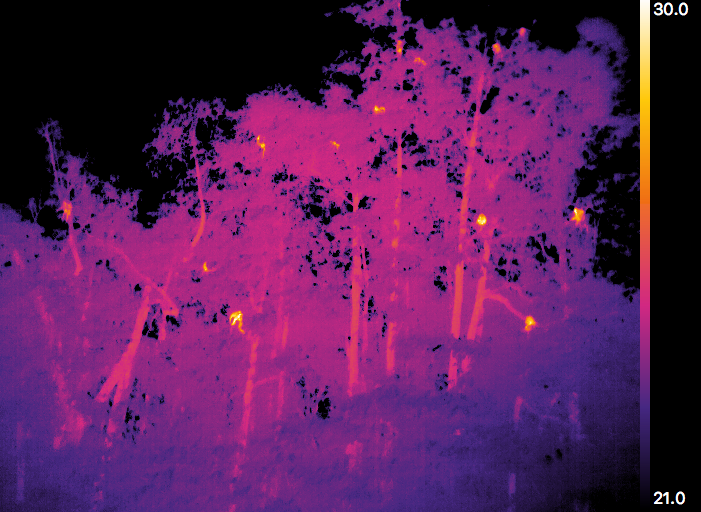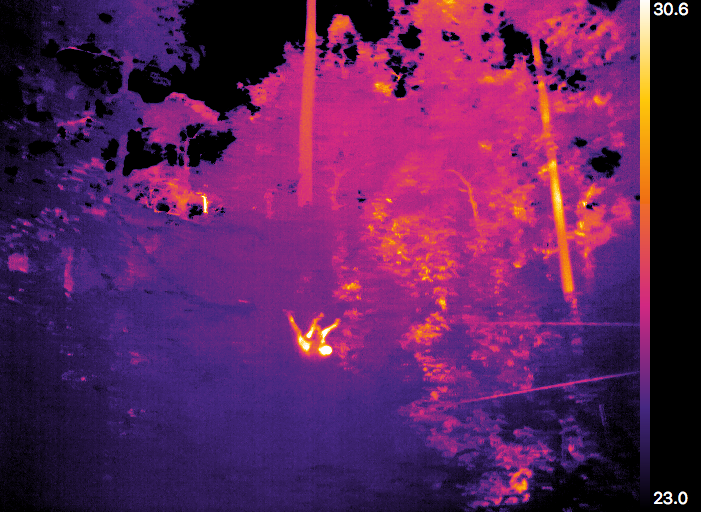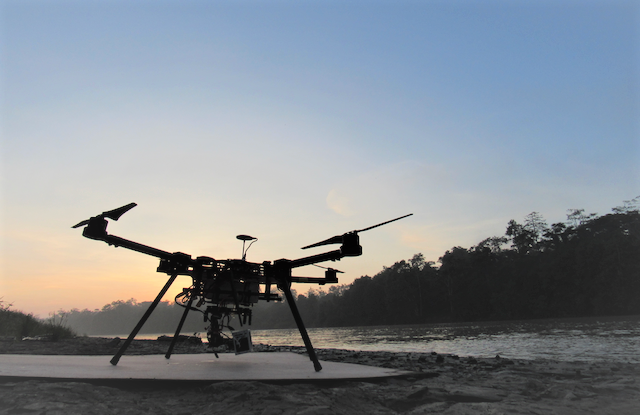- A research team hailed a breakthrough in their imaging system’s ability to detect and identify orangutans in tropical rainforest.
- They now plan for computer algorithms to report back what a thermal camera has seen in real time.
- The researchers believe the system could also be used to spot poachers targeting rare species.
A prototype system to identify rare species in real time using thermal-imaging cameras mounted on unmanned aircraft, or drones, passed its latest test when it successfully identified orangutans (Pongo pygmaeus) in Borneo’s rainforest. Having previously used the technologies to detect spider monkeys in Mexico and riverine rabbits in South Africa, a team of scientists developing the system plan to have it ready for widespread use in two years.
During field trials, the airborne thermal cameras detected 41 orangutans, each confirmed by observers on the ground. It also spotted proboscis monkeys, which it distinguished from the orangutans, and Asian elephants.

Thermal-imaging cameras detect animals’ body heat, so they do not require sunlight or a flash to illuminate their subjects and can be used at night.
The tropical rainforest trials demonstrated the cameras work in a challenging environment where animals are partially hidden by vegetation and where the heat of the wildlife could be masked by the temperature of the surrounding habitat.
The research team found the camera was able to pick up animals’ heat signatures through gaps in the vegetation, and they worked at first light before the surrounding environment had warmed up. Orangutans’ arboreal nature also made them easier for aerial cameras to spot.

“Two years from now, we’re hoping to roll this out as a ‘You tell us what you want, we can build a system that works for you,’” one of the team’s collaborators, Claire Burke, an astro-ecologist at Liverpool John Moores University (LJMU), told Mongabay in an interview. “We want this to be as useful as possible, which means we need to do field studies in as wide a range of environments, and with as many different species, as possible.”
But it’s the scientists’ methods of processing the data that are ground-breaking, Burke said. As previously reported by Mongabay, this aspect of the project has come from the field of astrophysics.
Different animals are warm and cold in different parts of their bodies, something which Burke calls their “unique thermal fingerprints.” The idea eventually is that object detection software on board the drones will be able to identify species from the images and notify researchers, saying what it has seen and where.

“Every identification the system gives will come with a confidence value,” Burke said. “It will say, ‘I am 95 percent sure that was an orangutan’, or even ‘I am 60 percent sure that was a man hiding in the bush’, and if he’s not supposed to be there, then the local authorities can go and sort him out.”
To date, the software has “learned” the thermal fingerprints of two species of antelope, rhinos, chimpanzees and baboons from trials conducted at a local safari park.
Serge Wich, an expert in primate behavioral ecology also at LJMU and the project’s lead conservationist, told Mongabay that the system could allow researchers to obtain more precise estimates of orangutan numbers. Australian researchers have advanced a comparable method combining drones, thermal imagery, and machine learning to automatically survey koalas and other cryptic species in eucalyptus forests and estimate error rates.
Currently, Wich explained, scientists estimate orangutan populations by counting their nests from the ground, but this method is cumbersome and time-consuming and may not detect declines of less than about 25 percent. In addition, many populations are counted by extrapolation because huge areas of habitat have not been surveyed.
Counts from thermal images taken from drone-mounted cameras are potentially more accurate than ground counts and can also cover a much larger area in less time. Field workers counting animals in rainforest can cover about 200 meters (650 feet) in an hour, explained Burke, but a fixed-wing drone can cover a kilometer (0.6 miles) in 10 minutes – roughly 30 times quicker.

“There are declines going on that we have not been spotting,” Wich said. “Our paper last year [in Current Biology] showed half the orangutan population of Borneo had disappeared between 1999 and 2015. That came as a big shock to us. By using this new system, we may be able to do more precise counts and over larger areas.”
The team will next try out the system on bamboo lemurs, which live in marshy areas around Madagascar’s Lac Alaotra, providing a new challenge for the thermal-imaging and object detection technologies.
Next steps in astro-ecology research
Thermal-imaging cameras have trouble accurately picking up an animal’s heat signature in hot environments, and the current technology cannot capture images at high resolution. Wich said the system will probably work best for animals, such as other great apes, that are relatively large and usually found in the open or high up in a forest. The drones with thermal cameras they used to detect spider monkeys produced more reliable counts than ground surveys when monkeys were found in large numbers.

So far, the cameras have been attached to multi-rotor drones, which have a maximum flying time of 30 minutes. Once the software is fully developed, the team will switch to fixed-wing models, which fly for between one and two hours. Burke estimated a complete system could be assembled for about $13,000.
The researchers are confident the system will also be able to spot and identify humans and could therefore be used by anti-poaching teams because poachers frequently operate under cover of darkness. “There’s lots of interest from national parks and private reserves,” Wich said.
FEEDBACK: Use this form to send a message to the editor of this post. If you want to post a public comment, you can do that at the bottom of the page.